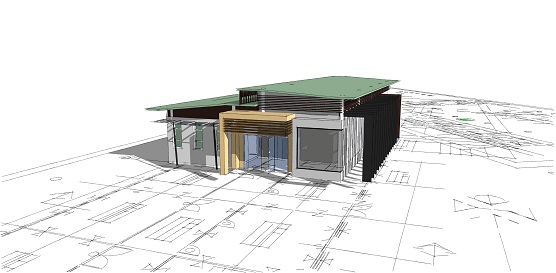Need to take a brief 10-minute SketchUp tour: a rundown of the layout, tools, and utilities you’ll interact with on a regular basis? Check out this brief walkthrough to see what you can expect from SketchUp and SketchUp for Web. ©Shutterstock/kittipong kongwatmai
©Shutterstock/kittipong kongwatmai
 ©Shutterstock/kittipong kongwatmai
©Shutterstock/kittipong kongwatmai- Modeling window: See the big area in the middle of your computer screen? That’s your modeling window. You build your model here, and your modeling window always shows a 3D view of your model, even if you’re looking at it from the top or side. Key features of the modeling window are the model axes: three green, red, and blue lines that help define the directional space of your model.
- Menu bar (Desktop only): If you’ve used a computer in the past 30 years, the menu bar is nothing new. Each menu contains a long list of options, commands, tools, settings, and other goodies that pertain to just about everything you do in SketchUp. You should generally refrain from using the menu bar to find things, because that requires that you remember the name of a tool, the menu it lives on, and where on the menu it is.
- Menu (web only): In SketchUp for Web, you will be using the menu a lot less to find tools but just as much to open files, save copies using Save As, and change settings.
- Search (web only): A recent addition to the SketchUp interface is this quick way to find and activate tools and look up shortcuts. If you’re using the web version (it’s not available in SketchUp Pro yet), you’ll find this really handy when you start learning tools and utility settings that you don’t use that often or have a hard time remembering.
- Toolbar: Click a toolbar button to activate a tool or command. You’ll start to use tool icons naturally while using SketchUp. In desktop versions, you can customize your SketchUp toolbar setup to show tools you use most often, or to not show those tools whose shortcuts you’ve remembered. In the web version, similar tools are nested together in the toolbar. So when you click the Rectangle tool icon, you’ll switch to the Rectangle tool but also see the other shape-drawing tools available to you. Similarly, the Tape Measure tool contains other tools for measuring and labeling things.
- Large toolset (desktop only): Usually, it’s better to turn off the Large Toolset and attempt to use core commands by shortcuts. But if you prefer a visual reference for tool icons, you may prefer leaving the Large Toolset on to have all the tools handy all the time. You can can control its visibility by choosing View→Toolbars (Mac: View→Tool Palettes).
- Status bar: Consider this your SketchUp dashboard. The status bar provides helpful information about the SketchUp tool you are currently using. It’s important to check the status bar for reminders about modifier keys: keystrokes that you use in combination with certain tools to perform additional functions. Soon enough, you’ll know how to copy by using the Move tool with a modifier key. You’ll definitely forget this key, and when you do, the place to look is the status bar. The status bar also relays step-by-step instructions for the tool’s operation, but you may be better off using the Instructor.
- Utility panels desktop only): Before long you’ll start to interact with utilities — things like colors and display settings — that are generally organized on the right side of your SketchUp window. In desktop versions, you control which utility settings are visible via the Window menu. In more recent PC versions of SketchUp Pro, you can manage the default tray of utilities: Choose Window→Manage Trays, and use the Manage Trays dialog box to reconfigure what you do (or don’t) see here. On a Mac, utilities look like dialogs except that they’re neatly collapsible, and you can stack them aside in tidy trays when you are not using them.
- Utility panels (web only): In the web version, all utility panels — for stuff like saving model views or libraries of model textures — are organized on the right side of the screen, accessible by their icons. Opening a utility panel slides open a larger interface where you can access one or multiple panels. Use the X next to a panel name to close it, or use the arrow icon at the top right of the panel to hide the utilities you are currently using.
- Measurements box: You use this box all the time as you model in SketchUp, but you’ll never need to touch it. Depending on what you’re doing, this box displays information about what you’re modeling or enables you to specify a precise length, angle, or other measurement while modeling.
- Context (right-click) menus: Whenever you have something selected in SketchUp, you can right-click your selection to reveal a shortcut menu of commands and options. These are always relevant to whatever you right-clicked, so the contents of each menu are different. If you decided to proceed without a mouse, you can still right-click a trackpad, usually by using two separated fingers.




